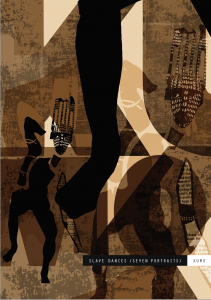Slave Dances (Seven Portraits) by Jono Podmore
Published by Psychomat – Psychomat PSY 06
Full colour A5 52 page zine available here from 23rd August 2021
£7 (+ p&p)
A companion to the album Slave Dances (Seven Portraits), available from:
https://sound-space.bandcamp.com/album/slave-dances
Released 23 August 2021 to commemorate International Day for the Remembrance of the Slave Trade and its Abolition,
Book design, illustrations and cover design by Dan Taylor
Cover design / frontispiece contains elements of ‘The Dancer’ (Joyce Treasure)
Section “The Dancer” and associated artwork by Joyce Treasure
“An essential accompaniment to the album, indeed a brilliantly educational document in its own right, is a full colour 52-page A5 zine, featuring soberly
beguiling artwork by Joyce Treasure and superb design by Dan Taylor. Here, Kumo explains in detail how he sourced, researched and put together these pieces, his recording methods and motivations in making the album. There is additional text also from Treasure, an essay based around her cover image The Dancer, in which she lays bare the insidious processes of cultural and mental colonisation which deprive both blacks and whites of true consciousness.”
My first discovery was that the essence of this music is a far cry from the superficial glitziness of Strictly Ballroom, or the geriatric end-of-pier dancehall. The truth is that these are all slave dances. They all derive from African American culture of the late 19th and early 20th century and carry with them the trauma of slavery and treasured remnants of African culture.
The work culminated in the seven-track album: Slave Dances (Seven Portraits) and the companion zine. The music is available for download at
https://sound-space.bandcamp.com/album/slave-dances
I am very white, at times almost transparent from lack of melanin. So what am I doing digging around in someone else’s story and deriving my own work from it? I asked my friend, artist Joyce Treasure, what she felt about this project. As a graduate of the Black Studies degree course at Birmingham City University, the first such course in Europe, she asked some probing questions about my intentions and made some painful comparisons. Eventually she gave me her support and went on to contribute her own art and words to the project.
These stories need to be told. Black people can be as unaware of much of this vital history as anyone else. Their story has been utterly colonised, censored and retold to them by whites over the generations, often removing all traces of black agency and context.
Despite the colour of my skin, I realised that this is in part my story too. I’m from Liverpool – a quick glance at my family tree reveals that none of my great-grandparents were born in the city. They came from Scotland, Ireland, Lancashire and Wales. They uprooted themselves from long, local traditions dating back generations, lured to Liverpool by the economic boom driven by the transatlantic trade built on the barbarity of slavery. Their children, my grandparents, would have sung and danced the Charleston, the Black Bottom, the Bunny Hug, perhaps even Shimmied. Indeed, my mother sang me the lullaby “Go to sleep my Little Picaninny” as her mother would have sung it to her, each generation sharing the appropriated culture of those enslaved whose suffering produced the wealth around them.
By identifying this in my own DNA I no longer feel like an exploitative voyeur mining another culture for my own benefit, I feel an even greater responsibility to decolonise our collective history and identify how slavery continues to touch us all, economically, socially and culturally.
The racism born of slavery exists within the white community so it is whites that have to engage with the problem and tackle it. It may be daunting but the fact is that black people have been telling whites about this for 400 years and yet the message never seems to penetrate. It is the responsibility of whites to stick our necks out and be counted; make mistakes, offend each other, risk accusations of appropriation or of becoming, God forbid, the “white saviour”, in order to get the conversation moving both between each other and the black community. Otherwise this central narrative in our economic and cultural lives will remain a sideshow and our true histories, no matter how vast and all encompassing, will remain hidden.
Each of the seven pieces on the album is derived directly from the original dances in the titles but each also functions as a portrait of a notable African American musician. Sometimes the link is directly from the content, other times via technical relationships in the music. Each is in homage to their achievements in the face of adversity and discrimination.
Jono Podmore AKA Kumo,
London
August 2021

Concerning the title
The use of the term Slave can be deeply problematic as it subtly dehumanises enslaved people and debases their culture. Yet the term ‘Slave Dances’ appears in music dictionaries to describe the origins of African American music. I decided to retain the term in the title of my work to pass on my own shock at seeing it in regular, though diminishing, use, employing it provocatively to contrast with the whitewashed history of popular dance music that we inherit.